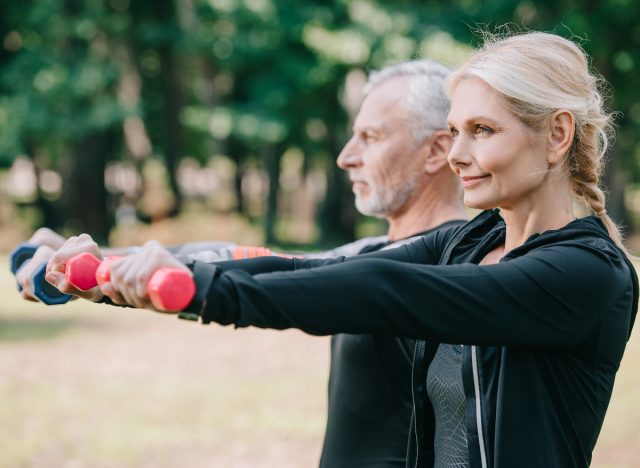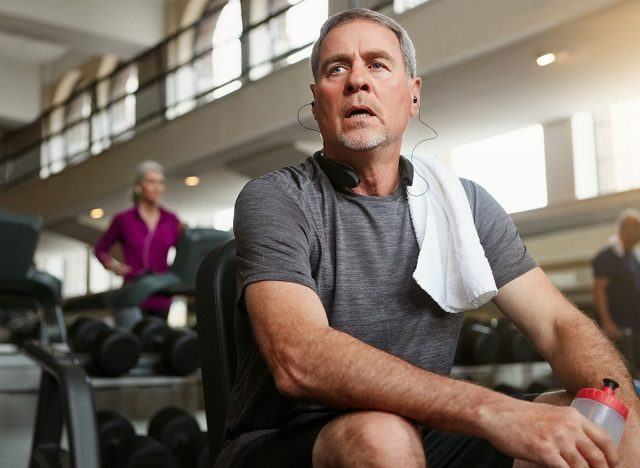How Much Daily Training Do You Need To Rebuild Muscle After 50?

After you hit 50, sarcopenia — the natural loss of lean muscle — starts to speed up. Why does this happen? Your levels of “muscle-supporting hormones” — including estrogen and testosterone — decrease, along with your body’s ability to synthesize new proteins, explains Coach Amanda Grimm, certified running coach and PT at We Run and sports and remedial massage therapist. Staying consistent with strength training can make all the difference in the world for rebuilding muscle, but how much daily training do you really need? We spoke with experts who spill the tea.
“After 50, your body naturally produces less testosterone, growth hormones, and IGF-1 – all crucial for building and maintaining muscle,” stresses Clif Marshall, senior director of coaching and pro training at D1 Training. “But here’s the good news: strength training acts like a hormonal wake-up call and every rep is an investment in your future. It boosts natural testosterone and growth hormone levels, while improving insulin sensitivity and metabolic rate. Your muscles don’t care how old you are, they respond to consistent, smart resistance training.”
Almost anyone can build muscle after 50 by being consistent with strength training, consuming a nutritious, protein-packed diet, and emphasizing rest and recovery, says Eric North, aka The Happiness Warrior—a wellness speaker, coach, and advocate redefining what it means to age with purpose, strength, and emotional vitality.
“Hormonal changes, such as declining testosterone and estrogen, can make muscle growth more difficult, but strength training can help stimulate new muscle growth into our 50s and well beyond,” he adds. “A balanced diet with plenty of carbohydrates and leafy greens is crucial for muscle protein synthesis. Metabolism also plays a role, and building muscle is a key factor to increase it and live a more optimal lifestyle.”
How Much Daily Training Do You Need To Rebuild Muscle After 50?

Unfortunately, the “use it or lose it” mentality is real, Marshall points out.
“Within three weeks of reduced activity, muscle strength and size begin to decline, especially in the lower body,” he explains. “After about two months of inactivity, most adults can lose up to 10 to 15% of their muscle strength. But muscle memory is powerful; once you start training again, those fibers come back faster than you’d think.”
That said, you don’t need to go to the gym 24/7 in order to make progress or see noticeable changes, says Marshall.
“For most adults over 50, 30 to 45 minutes of strength-based training three to five times per week is ideal, with functional movement every day,” Marshall explains. “The key is focusing on progressive overload; gradually increasing resistance, reps, or time under tension.”
Aim to address each muscle group two times a week—that’s the “sweet spot” for most. This frequency provides your muscles sufficient stimulus to grow, while giving your joints and connective tissue ample recovery time.
How Long Should Your Sessions Be?

“The magic is in consistency,” says Julie Dermer, longtime master instructor at SoulCycle, lifestyle influencer, and leader in the fitness space. “If shorter daily sessions fit your schedule and help you stay consistent, that’s a win. If you prefer three longer, focused workouts per week, that’s equally great.”
“A balanced program might look like an upper body workout on Monday and Thursday, lower body on Tuesday and Friday, with active recovery on Wednesday and the weekend,” Marshall says. “Recovery including sleep, hydration, and nutrition is as important as the reps you put in.”
When strength training, Grimm and Dermer recommend using a combination of tools: bodyweight moves, free weights, resistance bands, and machines.
A mix in resistance tools “[keeps] your body guessing and your muscles challenged,” Dermer points out.
For instance, bodyweight training is excellent for functional strength and joint stability, while resistance bands are portable, easy on the joints, and perfect for engaging the smaller stabilizing muscles.
Grimm agrees that “a balanced mix of methods will help to develop better all round strength, mobility and stability as well as leading to functional improvements.”
You Don’t Get Old From Lifting, You Get Old From Stopping

Above all else, prioritize proper form, full range of motion, and controlled tempo.
“At 50 and beyond, the goal isn’t just looking strong, it’s staying capable for whatever life throws your way,” Marshall says.
When you’re not lifting, Marshall recommends focusing on active recovery exercise, such as light cardio, mobility drills, or walking. These modalities keep your muscles primed and joints healthy.
“You don’t stop lifting because you get old; you get old because you stop lifting. Think of training as movement medicine, a daily dose keeps you strong, agile, and confident,” Marshall says.
Q: How much daily training do I need to rebuild muscle after 50?
A: 30–45 minutes of strength training, 3–5 days a week, plus daily functional movement. Train each muscle group twice weekly.